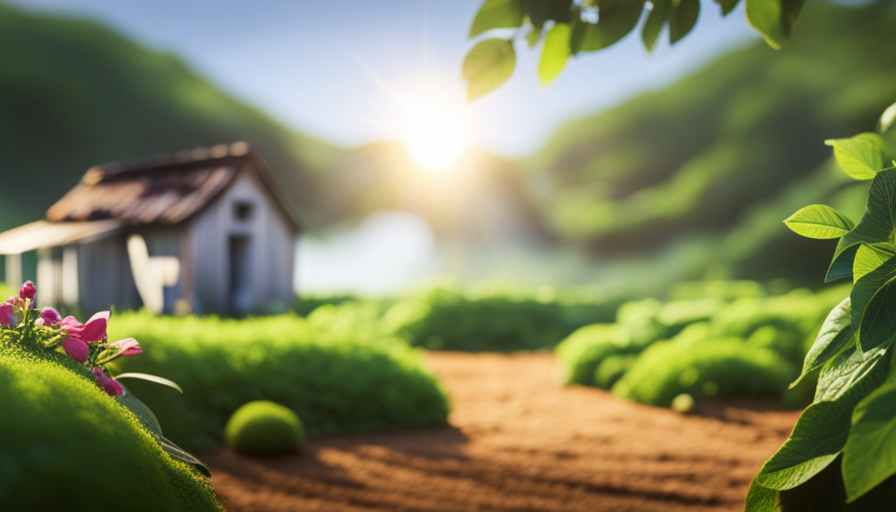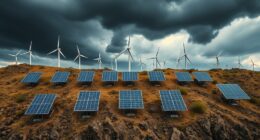Did you know that building a traditional home usually takes 6 to 12 months? But what if I told you that you could build a compact, off-grid cob house in just a fraction of that time, covering 200m2? Imagine the time and effort you could save!
Yes, you heard it right. In this article, I will guide you through the step-by-step process of constructing your very own off-grid tiny cob house, from gathering materials to moving in and enjoying your self-sufficient lifestyle.
With careful planning and efficient construction techniques, building a tiny cob house can be a rewarding and transformative experience. From site preparation and foundation to installing the roof and windows, I will provide you with detailed instructions on each stage of the construction process.
Additionally, I will delve into the electrical and plumbing systems, interior finishing and decoration, as well as off-grid power and water solutions.
So, if you’re ready to embark on this exciting journey and create your own sustainable sanctuary, let’s dive into the world of off-grid tiny cob houses.
Key Takeaways
- Off-grid tiny cob houses can be built faster than traditional houses, with an average construction time of 6-12 months.
- Careful planning and efficient construction techniques are important for timely completion of an off-grid tiny cob house.
- Off-grid power and water solutions, such as solar panels and rainwater harvesting, are commonly used in tiny cob houses.
- Regular inspection and maintenance of cob walls, along with proper insulation and energy-efficient windows, are crucial for the durability and energy efficiency of the house.
Gathering Materials and Planning
Gathering materials and planning, it’ll take some time to build that off-grid tiny cob house.
The first step in the process is creating a building timeline. This will help us estimate how long each phase will take and ensure that we stay on track. We will need to take into account factors such as weather conditions and availability of materials when creating the timeline.
Next, we need to estimate the cost of building the tiny cob house. This includes calculating the cost of materials, labor, and any additional expenses such as permits and inspections. By carefully estimating the cost, we can ensure that we stay within budget and avoid any unexpected financial burdens.
Once we have gathered all the necessary materials and created a detailed plan, we can move on to the next phase: site preparation and foundation. This involves clearing the land, leveling the ground, and laying the foundation for the house. By properly preparing the site, we can ensure a solid and stable foundation for our tiny cob house.
With the building timeline and cost estimation in place, we can now proceed with the exciting journey of building our off-grid tiny cob house.
Site Preparation and Foundation
Once you’ve cleared the land and prepared the foundation, you’ll be laying the groundwork for your cozy, self-sustaining cob home to take root and flourish. The next step in the process is site preparation and foundation construction. This involves excavation and leveling the land to create a stable base for your tiny house. Here’s what you need to know:
-
Excavation and leveling: Begin by clearing the site of any vegetation or debris. Then, excavate the area to the required depth, ensuring a level surface. This will provide a solid foundation for your cob house.
-
Foundation types: There are different types of foundations suitable for an off-grid tiny cob house. You can opt for a rubble trench foundation, which involves filling a trench with rocks and gravel to provide drainage. Another option is a concrete strip foundation, where concrete footings are poured along the perimeter of the house. Alternatively, you can choose a raised foundation, using concrete piers to support the structure.
-
Building permits: Before proceeding with site preparation and foundation construction, make sure to check local building codes and obtain any necessary permits. This will ensure that your cob house meets safety and structural requirements.
-
Constructing the cob walls: Once the foundation is in place, you can move on to constructing the cob walls, using the traditional cob building technique. This involves mixing clay, sand, and straw to create a durable and energy-efficient material for your home.
With the site prepared and the foundation laid, you’re now ready to start constructing the cob walls for your off-grid tiny home.
Constructing the Cob Walls
Now it’s time to roll up your sleeves and start crafting the sturdy cob walls of your charming, sustainable abode. Constructing the cob walls requires careful attention to detail and an understanding of cob wall techniques. Cob, a mixture of sand, clay, and straw, is an ancient building material that is both durable and environmentally friendly. To ensure a strong foundation, it is crucial to properly prepare the site and create a solid base for the walls. Once the foundation is ready, the cob mixture can be prepared and applied in layers. Each layer needs to be carefully compacted and smoothed to create a solid and even wall. As the cob walls are constructed, it is important to regularly check for any cracks or weaknesses and make necessary repairs. Proper cob wall maintenance includes regular inspection, reapplication of cob plaster, and protection from excessive moisture. As the cob walls take shape, you can already envision the cozy rooms and unique design of your off-grid haven. The next step in the construction process is installing the roof and windows, bringing your cob house closer to completion.
Installing the Roof and Windows
With the cob walls carefully constructed, it’s time to bring your sustainable abode one step closer to completion by installing the roof and windows. This phase of the construction process is crucial for protecting the interior from weather elements and ensuring energy efficiency. Time management plays a key role in this stage, as delays can lead to potential damage to the interior and further expenses.
Additionally, budget considerations are important when selecting roofing materials and windows that suit your needs and preferences. When it comes to the roof, there are various options to choose from, such as metal, shingles, or thatch. Each material has its own advantages and disadvantages, so it is essential to weigh the cost, durability, and aesthetics. Proper insulation is also crucial to minimize heat loss or gain.
As for the windows, they contribute to natural lighting and ventilation, reducing the need for artificial lighting and cooling systems. Selecting energy-efficient windows can further enhance the sustainability of your off-grid tiny cob house.
The next step after the roof and windows installation is to focus on the electrical and plumbing systems. These essential components will ensure a functional and comfortable living space.
Electrical and Plumbing Systems
To create a functional and comfortable living space, you need to focus on the electrical and plumbing systems, ensuring that your off-grid abode is equipped with all the necessary amenities to meet your needs and enhance your daily life experience. The electrical system is essential for powering your tiny cob house, and solar panels are the perfect solution for generating electricity in a sustainable and environmentally friendly way. By installing solar panels on the roof, you can harness the power of the sun to meet your energy needs. Additionally, incorporating a battery storage system allows you to store excess energy for use during cloudy days or at night.
When it comes to the plumbing system, rainwater harvesting is an excellent option for off-grid living. By installing a rainwater collection system, you can gather and store rainwater for various household uses such as washing dishes, flushing toilets, and watering plants. It’s important to have a filtration system in place to ensure the water is safe for consumption.
Here is a table outlining the key components of the electrical and plumbing systems:
| Electrical System | Plumbing System |
|---|---|
| Solar Panels | Rainwater Collection |
| Battery Storage | Filtration System |
With the electrical and plumbing systems in place, you can now move on to the next stage of building your off-grid tiny cob house: insulation and flooring.
Insulation and Flooring
Insulating and flooring your off-grid cob home is crucial for creating a cozy and comfortable living space that will enhance your daily life experience. When it comes to insulation, there are various techniques you can employ to ensure energy efficiency and maintain a comfortable temperature inside your tiny home.
One option is to use straw bales, which provide excellent insulation properties and are a sustainable choice. Another technique is to apply a layer of clay plaster mixed with straw, which not only insulates but also adds a beautiful texture to the walls. Additionally, installing double-glazed windows and using natural materials like sheep’s wool or cellulose insulation can further improve the insulation of your cob house.
Moving on to flooring, there are several eco-friendly options available. Cork flooring is an excellent choice as it is renewable, durable, and provides great insulation. Bamboo flooring is also a popular option due to its sustainability and durability. Another eco-friendly option is reclaimed wood, which not only adds character to your home but also helps reduce waste. When selecting flooring for your off-grid cob home, consider materials that are non-toxic and easy to maintain.
As we wrap up the discussion on insulation and flooring, it is important to note that these choices are essential for creating a comfortable and sustainable living space.
Now, let’s delve into the next section about interior finishing and decoration, where we will explore ways to personalize and add the finishing touches to your tiny cob home.
Interior Finishing and Decoration
Now let’s dive into the world of interior finishing and decoration to discover how you can add your personal touch and create a truly enchanting space in your cozy cob home.
When it comes to tiny house inspiration, there are countless sustainable design options available that’ll transform your space into a unique and inviting haven. One popular approach is to incorporate natural elements such as reclaimed wood, bamboo, or cork flooring. These materials not only add warmth and character to the interior but also align with the eco-friendly principles of off-grid living.
To enhance the visual appeal of your cob house, consider using vibrant colors and patterns in your choice of paint, wallpaper, or tiles. Bright accent walls can create a focal point and make the space feel larger. Additionally, incorporating strategic lighting solutions can add depth and ambiance to the interior. LED lights are energy-efficient and can be easily integrated into your off-grid power system.
Furthermore, don’t forget about the importance of functional and stylish furniture. Opt for multifunctional pieces that maximize space utilization, such as built-in storage or foldable furniture. Additionally, consider incorporating natural fabrics and textures for upholstery and bedding to maintain the sustainable theme.
As we move on to exploring off-grid power and water solutions, it’s important to remember that interior finishing and decoration play a crucial role in creating a harmonious and inviting atmosphere in your tiny cob home.
Off-Grid Power and Water Solutions
Exploring off-grid power and water solutions in your cozy cob home can transport you to a sustainable oasis. One of the most popular and efficient off-grid power solutions is solar energy. By installing solar panels on the roof of your cob house, you can harness the power of the sun to generate electricity. These panels use photovoltaic cells to convert sunlight into usable energy, which can then be stored in batteries for later use.
Solar energy is not only environmentally friendly but also cost-effective in the long run, as it reduces or eliminates the need for traditional electricity sources.
In addition to solar energy, rainwater harvesting is another key aspect of off-grid living. By collecting rainwater from your roof, you can have a reliable and sustainable water source. This water can be filtered and used for various purposes, such as drinking, cooking, and irrigation. Implementing a rainwater harvesting system in your cob house ensures that you have access to clean water while minimizing your reliance on municipal water supplies.
As we move closer to completing our off-grid cob house, the next step is to focus on final touches and quality control. With the power and water solutions in place, we can now turn our attention to adding those finishing decorative touches that will truly make our cob house a home.
Final Touches and Quality Control
Adding the final touches to our cozy cob home ensures that every detail is carefully crafted, creating a space that is both functional and aesthetically pleasing. Before we can fully enjoy our off-grid lifestyle, it is crucial to conduct a thorough quality inspection and make any necessary final adjustments.
Here are three important tasks that need to be completed during this stage:
-
Quality Inspection: We meticulously examine every aspect of the house, from the structural integrity of the cob walls to the functionality of the off-grid power and water systems. Any deficiencies or issues are identified and addressed to ensure our home meets the highest standards.
-
Final Adjustments: This stage involves making any necessary tweaks and improvements to ensure everything is in perfect working order. We focus on fine-tuning elements such as plumbing, electrical wiring, and insulation. Additionally, we pay attention to aesthetic details like painting, flooring, and cabinetry, ensuring they’re visually appealing and functional.
-
Finalize Documentation: As we near completion, it’s important to compile all the necessary documentation, including permits, warranties, and user manuals for the various systems installed. This documentation serves as a reference for future maintenance and troubleshooting.
By completing these final touches and conducting a thorough quality inspection, we can confidently move into our off-grid lifestyle, knowing that our cob home is built to the highest standards of quality and functionality.
Moving In and Enjoying Your Off-Grid Lifestyle
Once you’ve completed the final touches and moved into your cozy cob home, you can fully embrace and enjoy your off-grid lifestyle.
Living off the grid comes with numerous benefits that make the challenges of sustainable living worthwhile. One major advantage is the independence from traditional energy sources. By harnessing renewable energy from sources like solar panels or wind turbines, you can power your home without relying on the grid. This not only reduces your carbon footprint but also saves you money in the long run.
Another benefit of off-grid living is the opportunity to connect with nature. Surrounded by the beauty of the natural environment, you can enjoy a sense of peace and tranquility that is often lacking in urban areas.
Additionally, living off the grid allows you to live a simpler, more self-sufficient lifestyle. Growing your own food, collecting rainwater, and composting waste are just a few ways to reduce your impact on the environment while enjoying the fruits of your labor.
However, it’s important to acknowledge the challenges that come with sustainable living. Off-grid living requires careful planning and maintenance of your systems to ensure they function properly. Monitoring energy usage and water consumption becomes essential to avoid running out of resources. Additionally, living off the grid may require adjustments to your daily routines and habits, such as being mindful of energy usage and adapting to the natural cycles of daylight and weather patterns.
Once you’ve completed your cob house and moved in, the benefits of off-grid living are worth the challenges. By embracing a self-sufficient lifestyle and connecting with nature, you can enjoy a more sustainable and fulfilling way of life.
Frequently Asked Questions
How much does it cost to build an off-grid tiny cob house?
Building an off-grid tiny cob house can be a cost-effective and eco-friendly option. The construction cost depends on various factors such as the size, location, and desired features. However, on average, it can range from $10,000 to $30,000.
The construction time may vary depending on the complexity of the design and the availability of resources. It typically takes around 6 to 12 months to build a high-quality cob house, ensuring durability and sustainability.
What are the advantages of living in an off-grid tiny cob house?
Living in an off-grid tiny cob house offers numerous advantages. Firstly, it promotes sustainable living by utilizing natural and locally sourced materials like cob, reducing the environmental impact.
Secondly, it enables self-sufficiency through systems such as rainwater harvesting, solar power generation, and composting toilets. These features allow for a reduced reliance on external resources and utilities, resulting in lower costs and a smaller ecological footprint.
Overall, living in an off-grid tiny cob house provides a unique opportunity to embrace a more sustainable and self-sufficient lifestyle.
Can I customize the design of my off-grid tiny cob house?
Yes, you can customize the design of your off-grid tiny cob house according to your preferences. However, it’s important to consider building regulations and ensure that your design complies with them.
Customization options include choosing the layout, size, and features of your house. It’s advisable to work with a professional architect or builder who’s familiar with off-grid construction techniques to ensure that your design is both functional and structurally sound.
What are the maintenance requirements for an off-grid tiny cob house?
The maintenance requirements for an off-grid tiny cob house include regular inspections of the cob walls for any cracks or damage. It’s important to repair any issues promptly to maintain the structural integrity.
Additionally, the roof should be checked for leaks and the solar panels should be cleaned regularly to ensure optimal energy efficiency. Proper insulation and ventilation are also essential for maintaining a comfortable living environment and minimizing energy consumption.
Are there any legal restrictions or permits required to build an off-grid tiny cob house?
To build an off-grid tiny cob house, there may be legal restrictions and construction permits required. Legal restrictions can vary depending on the location and local regulations. It’s important to check with the local authorities to determine the specific requirements.
Construction permits may be necessary to ensure compliance with building codes and safety standards. Obtaining the necessary permits ensures that the construction process is legal and meets all necessary regulations.
Conclusion
In conclusion, building an off-grid tiny cob house is a labor-intensive but incredibly rewarding project. The process can take anywhere from several months to a year, depending on various factors such as the availability of materials and the level of customization desired.
However, the journey itself is akin to growing a garden. Just as each seed sown requires patience, nurturing, and time to flourish into a beautiful flower, so too does the construction of an off-grid tiny cob house require dedication, perseverance, and care.
And just like tending to a garden, the end result is a sanctuary that nurtures the soul and allows for a sustainable and fulfilling lifestyle.
Hi, I’m Emma. I’m the Editor in Chief of Tiny House 43, a blog all about tiny houses. While tree houses are often associated with childhood, they can be the perfect adult retreat. They offer a cozy space to relax and unwind, surrounded by nature. And since they’re typically built on stilts or raised platforms, they offer stunning views that traditional homes simply can’t match. If you’re looking for a unique and romantic getaway, a tree house tiny house might just be the perfect option.










